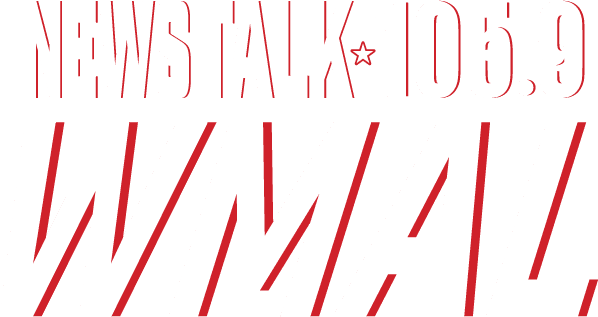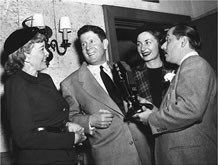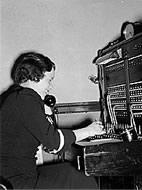A license was issued by the Radio Division, Bureau of Navigation, U. S. Department of Commerce, in October of 1925 to the M. A. Leese Optical Company to build and operate a new broadcast station in the nation’s capital on 1410 kilocycles with 15 watts of power. Call letters WMAL were assigned to the station, which went on the air Monday evening, October 12, 1925 from its studio and transmitter location atop a three story building at 710-712 Eleventh Street NW in downtown Washington, DC. Mr. M. A. Leese operated his “Washington Radio Forum” from 720 Eleventh Street NW, where offices for WMAL were first established. Mr. Leese, an optician, was WMAL’s owner, first manager and announcer.
In early 1926, WMAL moved to 1020 kilocycles on the dial. Its licensee name was changed in the spring of 1927 to the M. A. Leese Company. Mr. Leese withdrew from his optical business to concentrate on the broadcasting activities of his company. In May of 1927, WMAL was assigned to operate on 1310 kilocycles, but on June 1st switched to 990 kilocycles. Also in June, power was increased to 100 watts. WMAL’s slogan, used both on the air and off by September of 1927, was “Washington Radio Forum”. In September 1927, power rose to 250 watts. In November 1927, WMAL’s frequency was changed to 1240 kilocycles and its power increased to 500 watts by the end of the year. General offices of the station were located at 720 Eleventh Street NW while physical facilities were located at 712 Eleventh Street NW.

At 3:00 a.m., Saturday, November 11, 1928, WMAL was required to change dial positions to 630 kilocycles as a result of a major nationwide frequency reallocations plan placed into effect by the Federal Radio Commission. Also in November, the station was licensed to use 500 watts during the daylight hours, but was required to reduce nighttime power to 250 watts. Also in 1928, WMAL joined the Columbia Broadcasting System “chain” as its Washington area affiliate. In early 1929, ownership of the station was transferred to Mr. M. A. Leese individually. By late 1929 it maintained two studios at 712 Eleventh Street NW. Two 75 foot steel poles on the roof of the building supported its antenna wires.
Licensee name of the station was changed to the M. A. Leese Radio Corporation on January 12, 1932. By mid-1932, M. R. Baker had been appointed Manager of the station. Its CBS affiliation ended October 19, 1932 when that network moved to Washington’s WJSV (later changed to call letters WTOP). WMAL’s non-affiliated days were short, however, as it joined the NBC-Blue Network in January 1933. A five-year lease of WMAL was signed and placed into effect February 1, 1933 between the M. A. Leese Radio Corporation and the National Broadcasting Company Inc. “for the distribution of Blue programs”, and on February 28, 1933, the station was officially transferred to NBC, Inc. (lessee). Studios were moved in the spring of 1933 from 712 Eleventh Street NW to the National Press Building – three blocks from the White House – at 14th and F Streets NW. WMAL joined the current occupant there, NBC’s WRC, which became WMAL’s sister station. Kenneth H. Berkeley was appointed station director of WMAL in 1933. A performer on WMAL’s “Breakfast Club” in 1933 was “Red” Godfrey. Later to be network performer Arthur Godfrey, he moved two blocks away to WJSV by the end of 1933.
NBC’s Washington vice president Frank M. Russell supervised the operation of both WMAL and WRC by 1935. Studios were moved from the National Press Building to the Trans-Lux Theatre Building, 724 14th Street NW some three blocks north of the previous locale, in May of 1937. WMAL was installed on the second floor of the building with sister station WRC relocated to its third floor. Transmitting facilities continued to be located at 712 Eleventh Street NW.
In the late months of 1937, the lease to NBC was terminated, with station operation reverting back to the Leese interests. NBC, however, continued to operate it under a managerial agreement executed in the fall of 1937. Norman Leese was President of WMAL’s licensee at this time. On May 1, 1938, the M. A. Leese Radio Corporation was acquired by publishers of the “Washington Evening Star” newspaper, a family-owned concern headed by Board Chairman and President Samuel H. Kauffman. Norman Leese remained President and K. H. Berkeley continued as General Manager of WMAL. At this time, the basic NBC-Blue affiliate was in daily operation from 6:30 a.m. until 2:00 a.m. from a new 100 foot Blaw-Knox vertical radiator, installed atop the 100 foot high building at 712 Eleventh Street NW.
WMAL’s licensee name was changed to the Evening Star Broadcasting Company in 1939. The Federal Communications Commission on November 27, 1939 issued a construction permit for it to increase power to 5,000 watts. At this time, daytime power was 500 watts while nighttime broadcasts used 250 watts. Plans were then undertaken to move its transmitting site out of the downtown section to a new 100-acre site in the Bradley Hills area of Montgomery County, Maryland. WMAL increased power to 5,000 watts and inaugurated service from the new location on February 24, 1941, broadcasting from a one and a half story brick colonial Williamsburg-style transmitter building and four self-supported towers erected at the site to allow for fulltime one-pattern directional operation. The $200,000 plant was located just north of Bradley Boulevard, northwest of Bethesda. A license covering these changes was granted by the FCC to WMAL in May of 1941. While leased to NBC, it was 100% owned by Washington’s “Evening Star” interests.
The operating arrangement between NBC and the M. A. Leese Radio Corporation ended in February of 1942. The station then reverted back to the direct control of the Evening Star Broadcasting Company, of which K. H. Berkeley was executive vice president. Mr. Berkeley was also WMAL’s general manager. Studios continued to be located in the Trans-Lux Theatre Building, 724 14th Street NW and its Blue Network affiliation continued. That network changed its corporate name to the American Broadcasting Company, effective June 15, 1945. By 1946, S. H. Kauffman, president and part owner of the Evening Star, was given additional duties as president of its broadcasting subsidiary, the Evening Star Broadcasting Company. In 1952, studios were moved from the Trans-Lux Building to quarters at WMAL’s transmitting site on Greentree Road in Bethesda. WMAL became a 24-hour-a-day facility in April 1953. Vice President and General Manager K. H. Berkeley resigned in August 1954, leaving the District to embark on station ownership in Lake Wales, Florida. His replacement as general manager was Frederick S. Houwink. Also in 1954, John W. Thompson, Jr. replaced S. H. Kauffman as president of WMAL’s licensee. Studios were relocated to the “Evening Star Television Center” at 4461 Connecticut Avenue NW in 1956. Formerly the Chevy Chase Ice Palace, the building was purchased in 1947 to house the Evening Star’s WMAL-TV, which began telecasting in October of 1947 from renovated second floor studios. All WMAL studios and offices were now consolidated at one location. To allow expansion for television operations, WMAL moved radio studios back to the transmitter site on Greentree Road on June 1, 1959.
Andrew Martin Ockershausen was appointed station manager of WMAL in 1960. In 1962, Fred Houwink became a company vice-president while continuing as WMAL’s general manager. At this time, the station operated with a “middle-of-the-road” music format. Former general manager Kenneth H. Berkeley died September 13, 1964 at age 65 in Florida. Andy Ockershausen was elevated to general manager of WMAL in 1965, the year Fred Houwink was named a vice president of the parent firm. WMAL joined the American Information Network on January 1, 1968, the debut date of ABC’s new four network service. Vice President Frederick S. Houwink retired in March of 1970. Richard S. Stakes was named general manager and Harold L. Green was named station manager. Andy Ockershausen was named Vice President-Operations in the same year.
On January 12, 1971, Samuel H. Kauffman died at age 72. His son, John Hoy Kauffman was president of the firm at that time. On July 25, 1973, WMAL was granted a modification of its license enabling it to move to new studio quarters at 4400 Jenifer Street NW and was authorized to operate its transmitter by remote control from the new facility. By this time the station had begun using separate day and night transmitting patterns. In 1974 Charles A. Macatee became WMAL’s general manager.
In early January 1976, the Evening Star Broadcasting Company’s WMAL, WMAL-FM and WMAL-TV and majority control of the ailing newspaper were acquired from the Kauffman, Noyes and Adams families by publisher Joe L. Albritton’s Perpetual Corporation. After this $28.5 million acquisition, Mr. Albritton became board chairman and chief owner of WMAL’s license. On January 21, 1976, WMAL’s licensee name was changed to Washington Star Communications of Delaware Inc. Richard S. Stakes became president of Washington Star Communications Inc., but resigned in December of 1976. Mr. Albritton then assumed the presidency, with Robert Nelson becoming president of the broadcasting division. General Manager Charles Macatee resigned in January 1977.
A requirement of the purchase of the Evening Star properties included the sale of the radio or television properties. In March of 1977, WMAL and its FM companion were spun off to the American Broadcasting Companies and operated under a wholly owned subsidiary known as WMAL, Inc. The transfer fetched $16 million, a record price for radio properties at that time. Andrew Ockershausen was appointed executive vice president. WMAL’s programming was described as “50% Adult MOR and 50% News-Talk” by the fall of 1981. Using the Kahn-Hazeltine system, AM stereo broadcasting began in early August 1982.
On January 3, 1986, Capital Cities and ABC merged in a $3.52 billion deal. Thomas S. Murphy was chairman and CEO of the new firm. Frederick Weinhaus became president and general manager when Andrew Ockershausen resigned in March 1986. Weinhaus was transferred elsewhere within the company in January 1988. His replacement in May 1988 was Thomas Bresnahan.
On Friday, February 9, 1996, WMAL’s licensee was purchased by The Walt Disney Company for $18.5 billion. Effective October 1, 1996, the station’s licensee name was shortened to simply ABC, Inc.
Today, WMAL remains Washington’s oldest station to be operating under its original call letters.
WMAL is currently owned and operated by Cumulus Media.


























